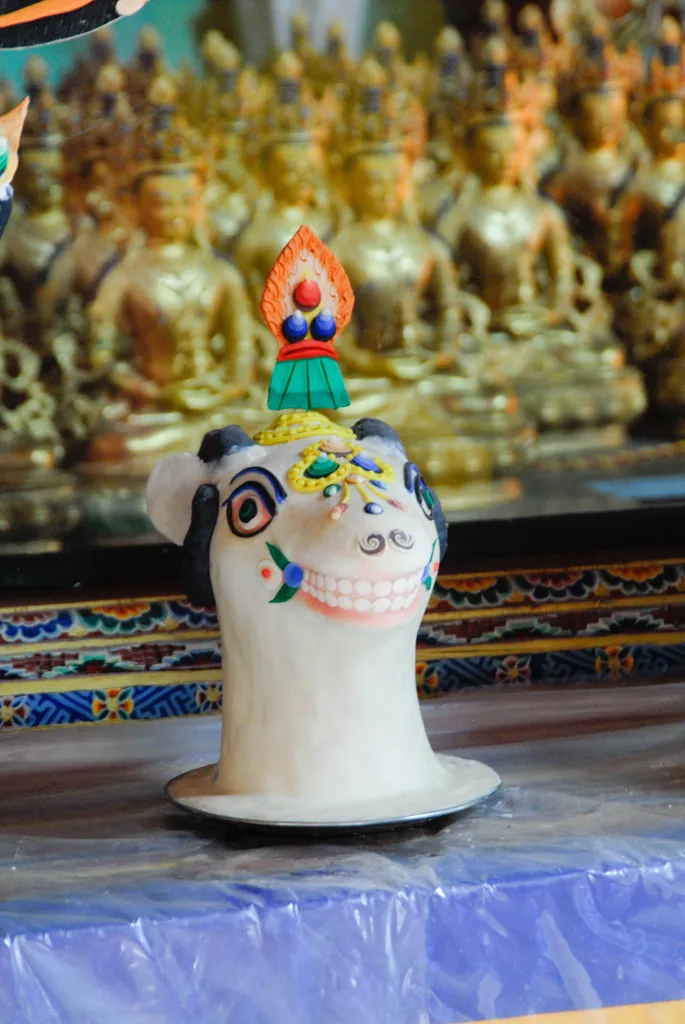Torma, or symbolic food offerings or deity supports, are rooted in the tradition of the Indian Buddhist concept of bali. Bali were a tribute, gift, or offering one makes to deities and spirits in the Vedic and Buddhist contexts. Throughout the Himalayan region, Vajrayana practitioners offer torma daily in Buddhist rituals and ceremonies. Tormas are also used in the Bon religion of Tibet.
Textual References to Tormas
Bali offerings are mentioned in the Jātaka tales where they are often offered to nature spirits known as yakkhas (Sanskrit yaksha). They also appear in other ritual texts such as the The Dhāraṇī of Refuge for the Preta Flaming Mouth.1 The Dhāraṇī “Giving Refuge to the Preta Flaming Mouth” In that text, the Buddha instructs his disciple in the offering of bali, or food offerings, combined with recitation of a dhāraṇī. The point of this ritual is to relieve pretas of their suffering of hunger and thirst.
In the Āryasaptabuddhakanāmamahāyānasūtra, the Seven Buddhas Sūtra, the tathāgata Kanakamuni instructs the bodhisattva Ākāśagarbha, on the use of a torma offering in conjunction with a mantra to cure people suffering from leprosy and other severe diseases.2Āryasaptabuddhakanāmamahāyānasūtra, The Seven Buddhas Sutra
Torma Meaning
The etymology of the Tibetan word torma is explained in terms of the two syllables. First, tor (གཏོར་) means to break up, scatter, or cast away. During a ritual, all the obscurations, impurity, evil influences, and negativity are cast away. Simultaneously, the practitioners offer up all excellent substances, giving them away to all sentient beings to overcome habitual stinginess. The motivation is said to be the love like that of a mother, Tibetan ma (མ་).
Tormas: Multipurpose Supports for Practice
Tormas serve many functions within Vajrayana practice. Often they are used as food offerings within ritual ceremonies in order to pacify, entreat, honor, or remind deities or other classes of beings of their pledges to aid practitioners. In other contexts, they represent the temporary residence of the deity and/or the entire mandala of the deity—the main figure and the retinue. They can also serve to represent a sick person who is the focus of healing pujas, as well as the effigy of demonic or obstructive forces that are to be tamed or overcome.
Tormas are made from dough, traditionally using roasted barley (tsampa) or wheat flour combined with water. In non-Himalayan countries, other substances such as oats can be used to achieve the same dough consistency. The dough is formed by hand into specific shapes according to the ritual purpose. Different traditions use uniquely stylized shapes for tormas according to their own ritual texts.
After the torma is correctly shaped, the dough is usually painted either white or red depending upon the type. Outer tantra tormas and offering tormas to certain classes of beings are usually glazed with melted butter to give them a “white” sheen. Other inner tantra tormas are glazed with a red color. Butter decorations or “ornaments” (དཀར་རྒྱན་) are then attached. These are made by shaping pats of butter in water, making discs and small balls. For ornate tormas, other colors may also be added. Many butter decorations are floral designs but other motifs such as moons and suns, rainbows and flames are also popular.
Examples of Tormas
There are many different shapes and purposes of torma. The most common torma is known as the zhelzé (ཞལ་ཟས་). This torma is often arranged as one of the set of seven outer shrine offerings. In this context, the torma symbolizes delicious and abundant food.
Another common torma type is the gektor (གེགས་གཏོར་) or torma for the obstructing evil forces. This torma is offered at the beginning of many pujas or retreats. The gektor features a dough-formed butter lamp appended to the torma. The practitioners offer the gektor as an enticement to expel evil influences that obstruct spiritual practice. This torma draws any negative influence outside of the ceremonial space, keeping the sacred space free from obstruction.


